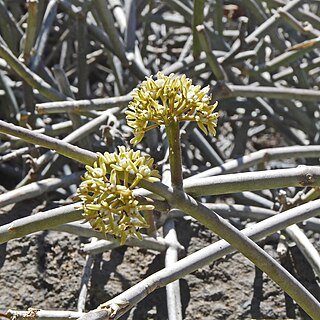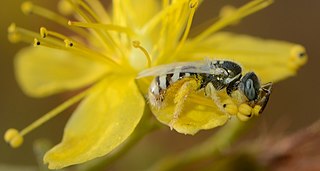
The wildlife of Cape Verde is spread over its archipelago of ten islands and three islets, which all have parks under their jurisdiction by decree promulgated by the Cape Verde government. Located off the west coast of Africa, the total land area of the island nation is 4,564 square kilometres (1,762 sq mi). The wildlife consists of many tropical dry forest and shrub land, endemic flora and fauna, and rare breeding seabirds and plants, which are unique to this group of islands.
Bandeirenica caboverda, locally known in Cape Verde as "mil-pés", is a species of millipedes of the family Odontopygidae. It is endemic to Cape Verde, where it occurs in the islands of Santo Antão and São Vicente. First described in 1987 as Spinotarsus caboverdus, it was placed in the genus Bandeirenica in 2000.
Ceylalictus appendiculata is a species of bee in the genus Ceylalictus, of the family Halictidae.
Ceylalictus taprobanae is a species of bee in the genus Ceylalictus, of the family Halictidae.

Artemisia gorgonum is a species of flowering plants of the family Asteraceae, endemic to Cape Verde. Its local name is losna or lasna. The plant plays a role in traditional medicine.

Euphorbia tuckeyana is a species of flowering plants of the family Euphorbiaceae. The species is endemic to Cape Verde. The species is named after James Hingston Tuckey. Its local name is tortolho. The plants are used for tanning hides.

Echium stenosiphon is a plant species of the family Boraginaceae. The species is endemic to Cape Verde. Its local name is língua-de-vaca, a name that may also refer to the related species Echium vulcanorum and Echium hypertropicum. The plant is used in traditional medicinal for a cough syrup.

Echium vulcanorum is a species of flowering plants of the family Boraginaceae. The species is endemic to Cape Verde. It is listed as an endangered plant by the IUCN. The species was first described in 1935 by Auguste Chevalier. Its local name is língua-de-vaca, a name that may also refer to the related species Echium hypertropicum and Echium stenosiphon. The oil of its seeds contains γ-linolenic acid, and is used for medicinal and dietary purposes.
Limonium jovibarba is a species of flowering plants of the family Plumbaginaceae. The species is endemic to Cape Verde. It is listed as critically endangered by the IUCN. The species was named by Carl Ernst Otto Kunze in 1891. Its local name is carqueja, a name that may also refer to the related species Limonium brunneri and Limonium braunii.
Limonium braunii is a species of flowering plants of the family Plumbaginaceae. The species is endemic to Cape Verde. It is listed as an endangered plant by the IUCN. The species was first described by the German Carl August Bolle as Statice braunii and was placed in the genus Limonium by the French Auguste Chevalier in 1935. Its local name is carqueja, a name that may also refer to the related species Limonium brunneri and Limonium jovibarba.

Erysimum caboverdeanum is a species of flowering plants of the family Brassicaceae. The species is endemic to Cape Verde. It is listed as a critically endangered plant by the IUCN. The species was first described by Auguste Chevalier in 1935 as Matthiola caboverdeana; it was placed into the genus Erysimum by Per Øgle Sunding in 1974. Its local name is cravo-brabo. It is used in traditional medicine.
Conyza feae is a species of aster flowers that belong to the family Asteraceae. The species is endemic to Cape Verde. It is listed as an endangered plant by the IUCN. First described as Nidorella feae, it was placed in the genus Conyza by Hiram Wild in 1969. The specific name feae refers to the Italian naturalist Leonardo Fea. Its local name is losna-brabo or losna-bravo. The plant plays a role in traditional medicine.

Sarcostemma daltonii is a species of flowering plants of the family Apocynaceae. The species is endemic to Cape Verde. The specific name refers to Joseph Dalton Hooker. The species was named by Joseph Decaisne in 1849. Its local name is gestiba. The plant is used in traditional medicine to relieve and treat dental problems.
Tornabenea insularis is a species of flowering plants of the family Apiaceae. The species is one of six species of the genus Tornabenea that are endemic to Cape Verde. The species was first described by Filippo Parlatore in 1849 as Tetrapleura insularis.

Tamarix senegalensis is a species of flowering plants of the Tamaricaceae family. It is a tree or twiggy shrub, that grows in saline soil, sandy desert and sea-shore.

The Greens–Green Group, founded in 1994 as Green Group, is a green political party in Spain. It is a founding member of the Roundtable for the Unity of the Greens in Spain. It was created as an electoral list in the 1994 European Parliamentary Elections. Since its creation, its spokesperson has been Esteban Cabal. It is not part of the European Green Party, and should not be confused with the EGP's previous representative in Spain, the Confederation of the Greens.

Periploca laevigata is a species of flowering plant in the family Apocynaceae, native to the Canary Islands, the Savage Islands and Cape Verde.
Tolpis farinulosa is a species of flowering plants of the family Asteraceae. The species is endemic to Cape Verde. It is listed as endangered by the IUCN. Its local name is mato-branco, a name that may also refer to the species Phagnalon melanoleucum and Verbascum cystolithicum.

Ceylalictus variegatus is a species of bee in the family Halictidae. The species was erected in 1789 by Guillaume-Antoine Olivier.










